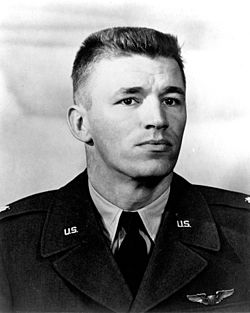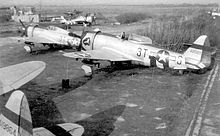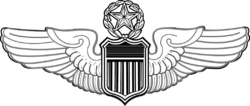- Charles J. Loring, Jr.
-
Charles Joseph Loring, Jr. 
Charles Joseph Loring, Jr.Born October 2, 1918
Portland, MaineDied November 22, 1952 (aged 34)
Kunwha, North KoreaAllegiance  United States of America
United States of AmericaService/branch  United States Army
United States Army
 United States Air Force
United States Air ForceYears of service 1942 - 1952 Rank  Major
MajorService number 13008A[1] Unit 22nd Fighter Squadron
36th Fighter-Bomber Squadron
80th Fighter-Bomber SquadronBattles/wars World War II
Korean WarAwards Medal of Honor
Distinguished Flying Cross
Purple HeartCharles Joseph Loring, Jr. (October 2, 1918 – November 22, 1952) was a fighter pilot in the United States Army Air Corps in World War II, and later in the United States Air Force in the Korean War. Loring rose to the rank of Major and posthumously received the Medal of Honor for his actions on November 22, 1952 above Kunwha, North Korea during a close air support mission.
Born in Portland, Maine, Loring joined the US Army in 1942 and was quickly selected to undergo pilot training. He spent several months stationed in Puerto Rico before being transferred to duty in the United Kingdom in 1944. There, he flew 55 combat missions in P-47 Thunderbolt aircraft before being shot down and serving six months as a Nazi German prisoner of war. By the outset of the Korean War, Loring was working administrative duties in the United States, but by 1952 had been transferred to combat duty in Korea.
During a patrol on November 22, 1952, Loring was leading a flight of F-80 Shooting Stars of the 36th Fighter-Bomber Squadron in an attack on a Chinese artillery position. During the run, his aircraft was struck by intense and accurate anti aircraft fire. Rather than abort the mission, Loring continued his diving run, aiming his disabled aircraft at the position and obliterating it, killing himself in the process. After his death, Loring was awarded the Medal of Honor and made the namesake of Loring Air Force Base in Limestone, Maine.
Contents
Biography
Charles Loring Jr. was born on October 2, 1918 in Portland, Maine.[2] He lived in the town throughout his early life, attending Cheverus High School, graduating in 1937.[3] He entered service in the same town at age 23.[2]
World War II
After the US entry into World War II, Loring enlisted in the United States Army in March 1942, and as a Private joined the Army Air Corps. By May 1942, he had been selected as an aviation cadet at the USAAF pre-flight school at Maxwell Air Force Base in Montgomery, Alabama. There, Loring completed primary, basic and advanced flight training courses. After graduating, Loring was commissioned as a Second Lieutenant in the Army Reserve with a pilot rating.[4]
After graduation in December 1942, Loring was assigned to the 22nd Fighter Squadron, 36th Fighter Group at Losey Army Airfield in Juana Díaz, Puerto Rico. The unit flew anti-submarine patrols as part of a defense force of the Panama Canal and Caribbean Sea areas.[4] During this time, Loring flew primarily P-39 Airacobra and P-40 Warhawk fighter and ground attack aircraft.[2] After a stint of this duty, the 36th Fighter Group returned to the United States to Charleston Army Airfield in Charleston, South Carolina. There, Loring and the other pilots of the unit trained with the P-47 Thunderbolt aircraft. It briefly moved to Scribner, Nebraska as part of this duty.[4]
 A group of P-47 Thunderbolts of the 22nd Fighter Squadron at RAF Kingsnorth, England in 1944. Loring was flying aircraft 44-19864 (left) when it was shot down over Belgium and he was made a Prisoner of War.
A group of P-47 Thunderbolts of the 22nd Fighter Squadron at RAF Kingsnorth, England in 1944. Loring was flying aircraft 44-19864 (left) when it was shot down over Belgium and he was made a Prisoner of War.
In March of 1944, Loring and the group moved to England to fly missions against Nazi German targets. The 36th Fighter Group flew out of RAF Kingsnorth in Kent, England flying reconnaissance, fighter escort and interdiction missions. The missions involved striking military strongpoints in northern Europe in preparation for Operation Overlord.[4]
Following the success of the Overlord operation, Loring continued to fly air support missions for the conflict. By December, he had flown 55 combat missions in World War II.[5] He had won a Distinguished Flying Cross for his actions supporting D-Day.[3] On December 24, 1944, Loring was flying a mission over Belgium when his P-47 was hit by flak artillery as he strafed ground targets.[5] Loring was subsequently captured and spent six months as a German Prisoner of War. He was liberated on May 6, 1945, two days before the end of the war on V-E Day.[4]
Korean War
After World War II, Loring stayed in the US Army Air Corps. he was promoted to Captain and began serving administrative roles in the post-war Air Corps, which in 1947 became the United States Air Force.[5] By the June 1950 outbreak of the Korean War, he was attached to Air University and was not immediately sent to Korea for combat duty. On February 3, 1952, Loring was reassigned to the 2353rd Personnel Processing Squadron at Camp Stoneman in Pittsburg, California. This unit was quickly moved into South Korea, where it was assigned to the 8th Fighter-Bomber Wing with the assignment of supervising training for replacement pilots before they were moved into combat units.[4] During this time he started flying with the 36th Fighter-Bomber Squadron and 80th Fighter-Bomber Squadron while assisting the new pilots.[5]
In July 1952, Loring transferred to the 36th Fighter-Bomber Squadron full-time, where he served as operations officer. In this role, Loring returned to combat duty, this time as a jet aircraft fighter pilot operating the F-80 Shooting Star. Missions for this unit primarily concerned close air support, air strikes and interdiction missions supporting United Nations Command ground troops in the country. In this role, Loring's unit fought primarily North Korean and Chinese ground targets. By November 22, 1952, Loring had completed 50 combat missions.[4]
At that time, the ground battle in Korea was a stalemate, with the two sides firmly entrenched along the 38th Parallel. Throughout November, the UN forces had been launching Operation Showdown against two targets: Triangle Hill and Sniper Ridge, northwest of Kunwha, 20 miles (32 km) north of the 38th Parallel. North Korean and Chinese artillery there posed an especially serious threat to ground troops of the US 2nd Infantry Division operating in the area. The artillery was heavily guarded, forcing the UN forces to use airpower to combat them.[2]
Medal of Honor action
Late in the morning of November 22, 1952, Loring led a flight of four F-80s on patrol over Kunwha. Upon radioing a forward air controller, he was told a T-6 Texan flying over Sniper Ridge had spotted a concentration of artillery near the ridge which was pinning down UN ground troops on the ridge. He was also told the artillery concentration was surrounded by a heavy presence of anti-aircraft guns. Loring ordered the flight to the location, spotting the artillery concentration.[5]
Immediately after Loring began his dive bombing run, he was spotted by the anti-aircraft batteries. The Chinese crews operating them were highly skilled, and even at a distance, the batteries fired an extremely accurate barrage which struck Loring's aircraft several times on the nose and fuselage.[5] The fire disabled the aircraft.[1] His wingmen, noting the damage, suggested he abort the bombing mission, as the flight was not far behind the lines and Loring's aircraft could have attempted the return trip. Instead, Loring ceased radio contact, and resumed what appeared to be the standard bombing mission. At 4,000 feet (1,200 m), however, Loring accelerated his aircraft at a 40-degree angle in what appeared to be a controlled maneuver, lining up the Chinese batteries. The other pilots reported they watched, stunned, as Loring dove his damaged aircraft into the battery position.[5] Loring was killed instantly in the impact, but his action resulted in the complete destruction of the battery position.[6]
Honors
Loring's remains were never recovered after the crash and he was listed as "Missing in action, presumed dead."[1] On May 5, 1954, Loring's widow received a Medal of Honor from President Dwight Eisenhower. At that time, it was also announced the newly built Air Force Base in Limestone, Maine would be named Loring Air Force Base in his honor.[6]
After his death, Loring's high school created a display in its alumni room dedicated to Loring. The display featured replicas of Loring's medals, as well as his high school diploma. The school also created an award named after him which honors students who have served in the military.[3]
Awards and decorations
Sebille was decorated several times during World War II. His decorations included the following medals:[1]











Command Pilot Badge Medal of Honor Distinguished Flying Cross Purple Heart Medal Air Medal
with 11 Oak leaf clustersDistinguished Unit Citation American Campaign Medal European-African-Middle Eastern Campaign Medal
with 6 service starsWorld War II Victory Medal National Defense Service Medal Korean Service Medal
with service starUnited Nations Service Medal for Korea Republic of Korea Presidential Unit Citation Korean War Service Medal[n 1] Medal of Honor citation
Loring was the fourth and final member of the US Air Force to be awarded the Medal of Honor in the war, after Louis J. Sebille, John S. Walmsley Jr. and George A. Davis, Jr.. All four Air Force recipients were pilots and all were awarded the medal posthumously.[7]
Rank and organization: Major, U.S. Air Force, 80th Fighter-Bomber Squadron, 8th Fighter-Bomber Wing
Place and date: Near Sniper Ridge, North Korea, November 22, 1952
Entered service at: Portland, Maine. Born: October 2, 1918, Portland, Maine
Citation:
Maj. Loring distinguished himself by conspicuous gallantry and intrepidity at the risk of his life above and beyond the call of duty. While leading a flight of 4 F-80 type aircraft on a close support mission, Maj. Loring was briefed by a controller to dive-bomb enemy gun positions which were harassing friendly ground troops. After verifying the location of the target, Maj. Loring rolled into his dive bomb run. Throughout the run, extremely accurate ground fire was directed on his aircraft. Disregarding the accuracy and intensity of the ground fire, Maj. Loring aggressively continued to press the attack until his aircraft was hit. At approximately 4,000 feet, he deliberately altered his course and aimed his diving aircraft at active gun emplacements concentrated on a ridge northwest of the briefed target, turned his aircraft 45 degrees to the left, pulled up in a deliberate, controlled maneuver, and elected to sacrifice his life by diving his aircraft directly into the midst of the enemy emplacements. His selfless and heroic action completely destroyed the enemy gun emplacement and eliminated a dangerous threat to United Nations ground forces. Maj. Loring's noble spirit, superlative courage, and conspicuous self-sacrifice in inflicting maximum damage on the enemy exemplified valor of the highest degree and his actions were in keeping with the finest traditions of the U.S. Air Force.[8]See also
Citations
Notes
- ^ In 2000 this award was made retroactive to all US military who served in the Korean War.
References
- ^ a b c d Korean War Honor Roll listing: Charles J. Loring entry, American Battle Monuments Commission, http://www.abmc.gov/search/koreanwar.php, retrieved August 7, 2011
- ^ a b c d Tillman 2002, p. 206
- ^ a b c Cornish, Caroline (2008-05-26), Major Charles Loring Honored At Cheverus High School, WCSH Channel 6 News, http://origin.wcsh6.com/news/local/story.aspx?storyid=87881&catid=2, retrieved 2011-09-28
- ^ a b c d e f g Air Force Biography: Major Charles J. Loring Jr., United States Air Force, 2011, http://www.af.mil/information/heritage/person.asp?dec=&pid=123224004, retrieved 2011-09-28
- ^ a b c d e f g Tillman 2002, p. 207
- ^ a b Tillman 2002, p. 208
- ^ Ecker 2004, p. 11
- ^ Ecker 2004, p. 206
Sources
 This article incorporates public domain material from websites or documents of the United States Army Center of Military History.
This article incorporates public domain material from websites or documents of the United States Army Center of Military History.
- Ecker, Richard E. (2004), Battles of the Korean War: A Chronology, with Unit-by-Unit United States Causality Figures & Medal of Honor Citations, McFarland & Company, ISBN 978-0786419807
- Tillman, Barrett (2002), Above and Beyond: The Aviation Medals of Honor, Washington, D.C.: Smithsonian Institution, ISBN 978-1588340566
External links
- "THE LORING REMEMBERS PROJECT - Profiles of those who served at Loring AFB". http://sites.google.com/site/loringremembers/home. Retrieved September 27, 2010.
Categories:- 1918 births
- 1952 deaths
- Air Force Medal of Honor recipients
- Recipients of the Purple Heart medal
- Recipients of the Prisoner of War Medal
- American military personnel killed in the Korean War
- United States Air Force officers
- American aviators
- Shot-down aviators
- Aviators killed in aviation accidents or incidents
- Victims of aviation accidents or incidents in Korea
- World War II prisoners of war held by Germany
- United States Army Air Forces pilots of World War II
- United States Army Air Forces officers
Wikimedia Foundation. 2010.

